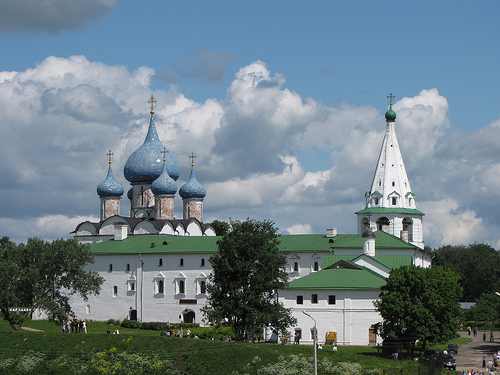

Constructed: 13th- 16th century
Cathedral of the Nativity in Suzdal is a UNESCO World Heritage Site situated within city Kremlin. It was originally constructed in the 11th century during reign of Vladimir II Monomakh. In 1222 dilapidated wooden building was taken apart and reconstructed in white stone and bricks. Original structure included three domes after Trinity. In the 17th century the church was reconstructed and two more domes were added. Five domes on a Russian Church represented God in the centre and the four Gospels given to Orthodox Christians. Colourful frescoes inside date back to 13th, 15th and 17th centuries. The interior of the church also holds burial tombs of Schuyski family, children of Yury Dolgoruky and many others. It was closed during Soviet Rule, but today it is open as a museum as well as working Orthodox church.
The construction of the first cathedral dates back to the beginning
of the 12th century, by the time of the reign of Vladimir Monomakh. The
building was built from plinth by Kyiv craftsmen.
According to
George Wagner, already in 1148 the cathedral was dismantled, after which
it was rebuilt, but not from plinth, but from rubble stone. Nikolai
Voronin and Sergei Zagraevsky denied the existence of the 1148
cathedral.
According to the Laurentian Chronicle, in 1222, by
order of Yuri Vsevolodovich, the dilapidated building was dismantled,
and in its place a new one was built in three years, which stood until
the 15th century. According to the surviving lower parts of this
cathedral, it can be judged that it was three-aisled, six-pillared,
three-apsed, three-fortified.
Academician of the Russian Academy
of Arts Sergei Zagraevsky showed that the construction of this cathedral
and other large white-stone churches of the era of Grand Duke Yuri
Vsevolodovich was led by the specific prince of Yuriev-Polsky Svyatoslav
Vsevolodovich.
In 1445 Kazan Tatars burned down Suzdal. As a
result of the fire, the upper part of the cathedral collapsed.
In
1528, Gennady, Bishop of Suzdal, received from the Grand Duke Vasily
III, father of Ivan the Terrible, permission to rebuild the cathedral
church. As a result, the old walls were dismantled down to the arcade
belt with women's masks and replaced with brick ones. Previously, the
three-domed cathedral received a five-domed completion and was painted
from the inside in the 17th century. Thus, the cathedral has reached our
days with great changes. Its lower part belongs to the 13th century, the
upper one to the 16th. The wall paintings of the 13th, 15th, and 17th
centuries have been preserved in the interior.
In 1233, the
cathedral was decorated with fresco paintings by Bishop Kirill from
Rostov or Suzdal. Fragments of this painting were discovered in 1938.
The most important part of the find is the image of two elders in the
upper part of the southern apse.
The cathedral is located in the
center of the ring of earthen ramparts, in the bend of the Kamenka
River. The temple was on fire several times. The sons of Prince Yuri
Dolgoruky, princes from the Shuisky family and others are buried in the
cathedral.
The western and southern gates of the Nativity
Cathedral in Suzdal are an outstanding monument of Russian applied art
of the first third of the 13th century. The gates consist of a wooden
base, upholstered with copper sheets, and decorated with images made
using the “fire gilding” technique. The western gates contain scenes of
the Christological cycle and partly of the Theotokos, while the southern
gates are mainly the deeds of angels and in particular the Archangel
Michael.